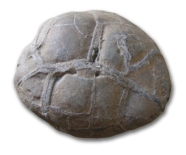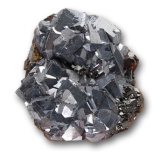The mild-mannered gypsum is not only a pretty sulfate to look at, but is harvested for numerous functions. The crystals are tabular, and often twinned. It can also form massive, granular, and fibrous habits. Radiating forms are called “daisy gypsum,”, and rose-shaped forms “desert rose.” Gypsum tends to be fairly drab with color, varying from near colorless, white, and gray, to a more green, yellow, or reddish hue. Its name comes from the Greek word “gypsos,”, meaning chalk or plaster.
It is mined for use as a fertilizer, plaster, chalk, and sheetrock / gypsum board. The granular form called alabaster is used in carving and sculpture. “Plaster of Paris” is dehydrated gypsum – by adding water back into the powder, the mixture creates an exothermic reaction (gives off heat), and “sets” into a hardened form. This is useful for making casts of objects. The fibrous crystal form is called “satin spar” and “senelite.”

Selenite – fibrous form

Alabaster – granular gypsum

Desert Rose – rosette gypsum
Gypsum has a white streak, but ranges from transparent to opaque. It is a very common mineral found in many locations. It can be deposited from lakes and seawater, hot springs, and other evaporative environments.
**Becky Trivia** Two fossil sites across North Dakota, on opposite ends of the state, hold gypsum. To the east, the Pembina Gorge locality once held a vast inland sea. Gypsum is so plentiful there it is the main mineral replacing the mosasaur and fish fossils, giving them a very soft, fragile form. Just off site, people can wander and pick up satin spar spears ranging from clear to black. To the west, the Whiskey Creek locality was once a swampy environment similar to the everglades. Sheets of gypsum can be found in and around those crocodile fossils as well.
The chemical formula is CaSO4·2H2O, and a hardness of 2 on the Mohs scale.
Pellant, Chris. Rocks and Minerals. New York: Dorling Kindersley, 1992. Print. Pg. 110.





















